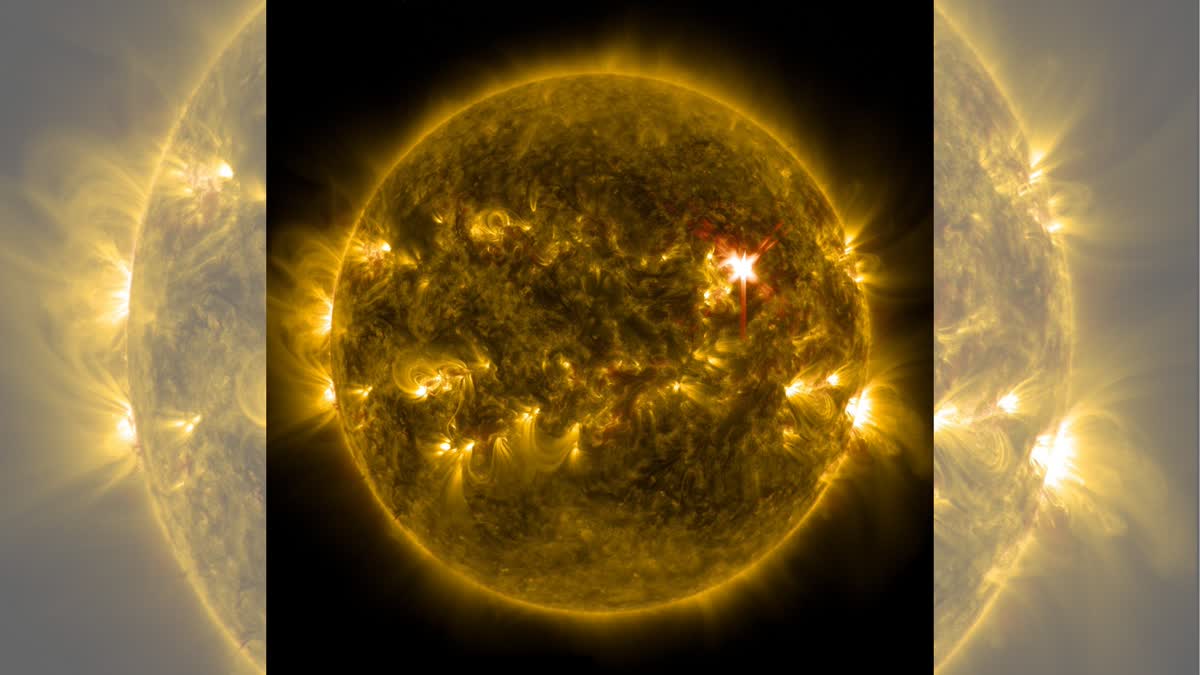Bengaluru: The Indian Institute of Astrophysics (IIA) has designed, assembled, and tested the Visible Emission Line Coronagraph (VELC), one of the seven payloads of India's first solar scientific space mission Aditya-L1 conceived to study the sun.
The Indian Space Research Organisation (ISRO) is all set to launch Aditya-L1 from its Sriharikota launch pad in Andhra Pradesh on Sept. 2. Here is everything you should know about the VELC on board
Building the VELC- The IIA has said the VELC was developed in close collaboration with the ISRO, in a statement. "IIA had to build India's first large sized 'Class to Clean Rooms' at (sic) its CREST campus in Hosakote to assemble VELC."
Six other payloads onboard Aditya-L1- The satellite will carry six more payloads - Solar Ultraviolet Imaging Telescope (SUIT), Aditya Solar Wind Particle Experiment (ASPEX), Plasma Analyser Package for Aditya (PAPA), SoLEXS-Solar Low Energy X-ray Spectrometer (SoLEXS), High Energy L1 Orbiting X-ray Spectrometer HEL1OS, and Magnetometer with enhanced science scope and objectives possible by extensive remote and in-situ observation of the Sun.
-
🚀PSLV-C57/🛰️Aditya-L1 Mission:
— ISRO (@isro) August 28, 2023 " class="align-text-top noRightClick twitterSection" data="
The launch of Aditya-L1,
the first space-based Indian observatory to study the Sun ☀️, is scheduled for
🗓️September 2, 2023, at
🕛11:50 Hrs. IST from Sriharikota.
Citizens are invited to witness the launch from the Launch View Gallery at… pic.twitter.com/bjhM5mZNrx
">🚀PSLV-C57/🛰️Aditya-L1 Mission:
— ISRO (@isro) August 28, 2023
The launch of Aditya-L1,
the first space-based Indian observatory to study the Sun ☀️, is scheduled for
🗓️September 2, 2023, at
🕛11:50 Hrs. IST from Sriharikota.
Citizens are invited to witness the launch from the Launch View Gallery at… pic.twitter.com/bjhM5mZNrx🚀PSLV-C57/🛰️Aditya-L1 Mission:
— ISRO (@isro) August 28, 2023
The launch of Aditya-L1,
the first space-based Indian observatory to study the Sun ☀️, is scheduled for
🗓️September 2, 2023, at
🕛11:50 Hrs. IST from Sriharikota.
Citizens are invited to witness the launch from the Launch View Gallery at… pic.twitter.com/bjhM5mZNrx
Initial plan- According to the IIA, the present mission was conceived as Aditya-1. It was proposed to carry a 400 kg class satellite carrying lone payload developed by the institute - the VELC. As per plan, it was to be launched in an 800 km low earth orbit.
How Aditya-1 became Aditya-L1-Further brainstorming accounted the fact that any satellite placed in the halo orbit around the first Lagrangian point (L1) of the Sun-Earth system has the major advantage of continuously viewing the Sun without any occultation/eclipses.
This is how the Aditya-1 mission was revised to "Aditya-L1 mission". It will be inserted in a halo orbit around the L1, which is 1.5 million km from the earth towards the Sun, the institute explained.
What is the VELC capable of? The VELC payload on-board Aditya-L1 is an internally occulted solar coronagraph with simultaneous imaging, spectroscopy and spectro-polarimetry channels close to the solar limb. The VELC is designed to image solar corona, according to the IIA.
Both imaging and spectroscopic observations obtained by the VELC payload are key to study the diagnostic parameters of solar corona and dynamics as well as origin of the coronal mass ejections and magnetic field measurements of the solar corona.
Stokes vector measurements in the plane-of-sky and imaging in white-light are the unique features of this payload, according to the institute said.
Understanding solar corona- The scientific studies undertaken by Aditya-L1 will help enhance understanding of the solar corona and provide vital data for space weather studies.
-
Explained: Aditya-L1 mission, India's first space-based observatory to study the Sun #AdityaL1mission #AdityaL1 #ISRO #ISROMissions https://t.co/xcJCLxCiY7
— ETV Bharat (@ETVBharatEng) August 30, 2023 " class="align-text-top noRightClick twitterSection" data="
">Explained: Aditya-L1 mission, India's first space-based observatory to study the Sun #AdityaL1mission #AdityaL1 #ISRO #ISROMissions https://t.co/xcJCLxCiY7
— ETV Bharat (@ETVBharatEng) August 30, 2023Explained: Aditya-L1 mission, India's first space-based observatory to study the Sun #AdityaL1mission #AdityaL1 #ISRO #ISROMissions https://t.co/xcJCLxCiY7
— ETV Bharat (@ETVBharatEng) August 30, 2023
Amid the lunar exploration, the ISRO has decided to study the sun as well and is all geared up for the launch. (with PTI inputs)



